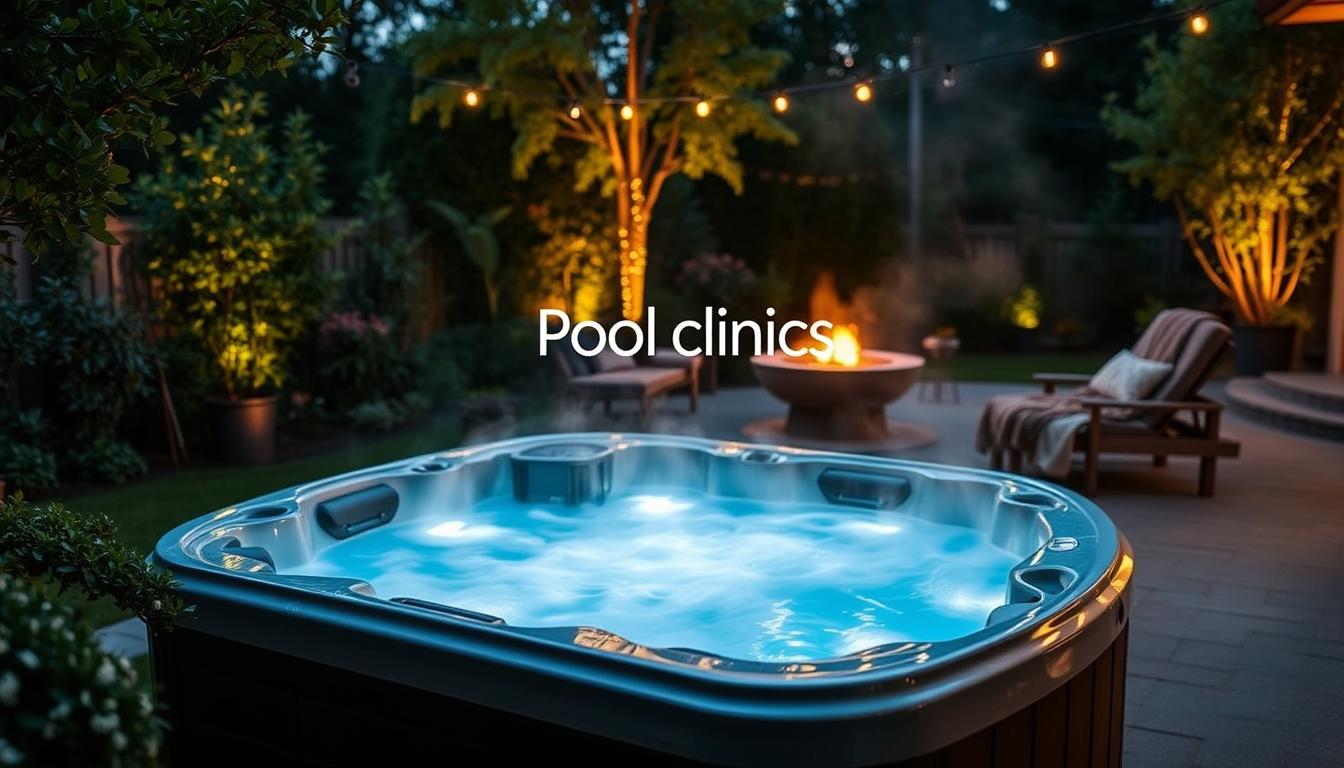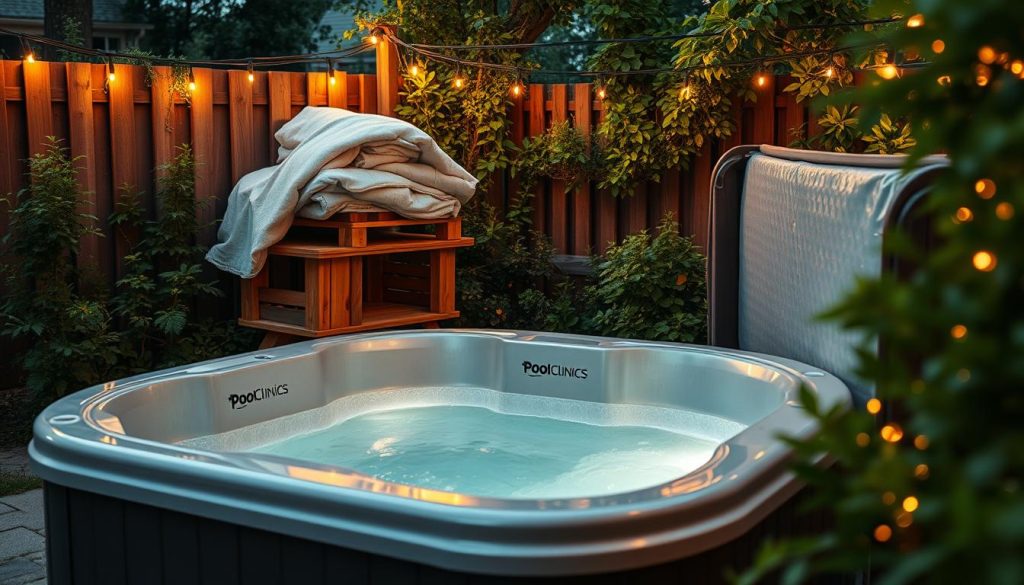
Waiting for your hot tub to warm up can be frustrating. We all want to relax in our personal oasis after a long day. Let’s explore ways to speed up heating and boost efficiency.
These tips will help you enjoy your hot tub sooner. We’ll cover insulation, landscaping, and maintenance to optimize performance. Get ready to enhance your hot tub experience!
Our expert advice will make your hot tub hotter and more enjoyable. You’ll learn to heat it faster and maintain the perfect temperature. These strategies work for both new and experienced hot tub owners.
Key Takeaways
- Invest in a high-quality, well-insulated hot tub cover to trap heat and speed up warming times.
- Enhance your hot tub’s insulation with high-density foam to reach the desired temperature faster and reduce energy bills.
- Activate your hot tub jets to circulate water, distribute heat evenly, and prevent cold spots.
- Use a thermal spa blanket to add an extra layer of insulation, trap heat, and help the water warm up quicker.
- Maintain your hot tub regularly to ensure optimal heating performance and prevent delays caused by dirty filters or imbalanced water chemistry.
Maximize Your Hot Tub Insulation
Effective insulation is key to hot tub heating efficiency. By using quality materials, you can improve heat retention and save energy. Our experts share tips to optimize your hot tub’s heating system for a cozy soak.

The Importance of a High-Quality Hot Tub Cover
A well-insulated cover prevents heat loss from your hot tub. Up to 60% of heat escapes from the water’s surface. Invest in a durable cover, at least 10 cm thick in the center.
Choose a cover with tapered edges to allow rain and snow runoff. This will significantly boost your hot tub’s heating efficiency.
Enhancing Insulation with Natural Materials: Cedar and Thermowood
The right materials can greatly improve heat retention in hot tubs. Western Red Cedar and Thermowood are excellent natural insulators. Cedar has an R-value of 1.35 per inch, trapping heat effectively.
Thermowood, created through thermal modification, has an altered structure that enhances heat retention. It traps air, making it an ideal insulator for hot tubs.
The thickness of wood in our hot tubs is crucial for insulation. At 3.85 cm (1.5 inches), these materials provide significant insulating power. This improves efficiency and reduces energy costs over time.
| Material | R-Value per Inch | Thickness Used | Total R-Value |
|---|---|---|---|
| Western Red Cedar | 1.35 | 3.85 cm (1.5 inches) | 2.025 |
| Thermowood | 1.2 | 3.85 cm (1.5 inches) | 1.8 |
Using these heat retention techniques and insulating materials creates an energy-efficient hot tub experience. Stay tuned for more expert advice on optimizing your hot tub settings.
We’ll share additional heating system tips to further enhance your hot tub’s performance. Enjoy a warm, relaxing soak without breaking the bank.
Optimizing Your Hot Tub Settings for Efficiency
Optimizing hot tub settings is key to reducing energy use and maintaining ideal heating. Simple adjustments can boost efficiency without sacrificing comfort or performance. Let’s explore smart strategies for your hot tub.
The Role of Jets in Heating Your Hot Tub
Jets play a crucial role in efficient hot tub heating. They circulate water and spread heat evenly, preventing cold spots. This reduces heating time and saves energy.
Run the jets briefly before entering the tub. This ensures a consistent, comfortable temperature throughout your soak.
Utilizing a Thermal Spa Blanket for Added Heat Retention
A thermal spa blanket is an effective tool for energy efficiency. It adds insulation, trapping heat and warming water faster. The blanket also retains heat when the tub isn’t in use.
This affordable solution can significantly reduce your hot tub’s energy consumption. It’s easy to use and makes a noticeable difference.
Consider your overall approach to hot tub heating. Heat water in increments to avoid energy surges from heating cold water all at once.
If possible, heat during off-peak electricity hours for lower costs. Set your tub to the lower end of comfortable temperatures. Increase only when necessary for significant energy savings.
| Hot Tub Temperature Setting | Energy Saving Potential |
|---|---|
| Lowering temperature by 1°F | 3-5% energy savings |
| Keeping hot tub at 100°F instead of 104°F | Up to 20% energy savings |
| Reducing temperature when not in use | 10-15% energy savings |
These tips help you enjoy your spa while minimizing your energy footprint. Small changes in settings and habits lead to big savings over time.
By optimizing your hot tub, you’ll create a more sustainable and cost-effective investment. Enjoy your relaxing soaks guilt-free!
How to Make Hot Tub Hotter: Simple Hacks for Faster Heating
Tired of waiting for your hot tub to warm up? Try these simple hacks to heat your tub faster. These tips will help you enjoy a cozy soak quickly.
Strategic Landscaping for Wind Protection and Heat Retention
Your hot tub’s location affects its heating efficiency. Windy spots can slow down heating and make soaking less pleasant. Install your tub in a sheltered area or create a windbreak with screens or hedges.
This buffer against wind will speed up heating and offer more privacy. Your hot tub will heat faster, letting you enjoy it sooner.
Regular Maintenance for Optimal Heating Performance
The heater, pump, and jets are key to your hot tub’s temperature. High-quality, well-maintained parts heat faster and cost less to run. Regular upkeep keeps these components working well.
Here are some tips for the best heating performance:
- Clean and replace filters regularly to prevent clogging and heater burnout
- Check for air in the lines, as this can cause premature heating unit failure
- Replace heaters after 3-4 years of regular use to maintain efficiency
- Keep the hot tub on if you plan to use it frequently to save money and time
Balancing Water Chemistry to Prevent Heating Delays
Balanced water chemistry is crucial for efficient heating. High alkalinity can cause scale buildup, making your tub work harder to heat. Regular water testing helps the system run smoothly.
Balancing chemical levels prevents excessive heating due to water issues. This ensures your hot tub heats up quickly and efficiently.
| Water Chemistry Parameter | Recommended Range | Impact on Heating |
|---|---|---|
| pH | 7.2 – 7.8 | Unbalanced pH can cause corrosion and scale buildup, reducing heating efficiency |
| Alkalinity | 80 – 120 ppm | High alkalinity can lead to scale formation, making the heater work harder |
| Sanitizer (Chlorine or Bromine) | 1 – 3 ppm | Proper sanitizer levels prevent bacteria growth and maintain clean, efficiently heated water |
These hacks and tips will help your hot tub heat up faster. Regular care and good water chemistry improve your soaking experience. They also extend the life of your hot tub parts.
Conclusion
Proper insulation, strategic settings, and regular maintenance are key to maximizing hot tub heat efficiently. A high-quality, well-insulated cover and natural materials like cedar can reduce heat loss. Optimizing jet settings and using a thermal spa blanket contribute to efficient hot tub usage.
Smart landscaping for wind protection and balanced water chemistry boost heating performance. These tips save energy costs and extend your hot tub’s lifespan. Solar power is an eco-friendly option for heating inflatable hot tubs, offering long-term savings.
By following these energy-saving tips, you can enjoy your hot tub without high electricity bills. Regular maintenance ensures a blissful, eco-friendly soaking experience. Embrace these strategies to create the perfect relaxation oasis.







